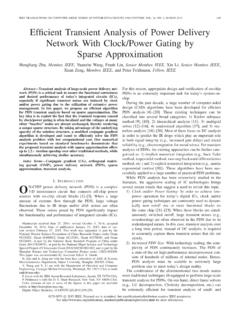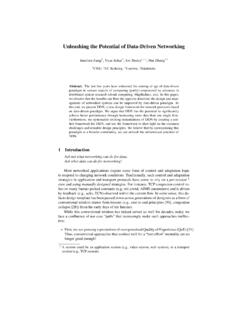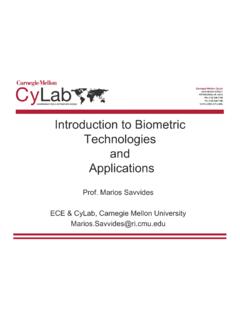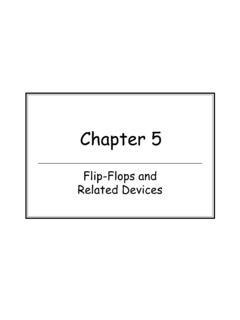Transcription of SEMICONDUCTOR DEVICES AND SAMPLE distribution …
1 SEMICONDUCTOR DEVICES AND TECHNOLOGY David W. Greve Department of Electrical and Computer Engineering Carnegie Mellon University With the exception of clearly identified illustrations, all material copyright Greve, 2012. This document may not be reproduced without permission from the author Second printing. SAMPLE not for distribution Contents chapter 1: SEMICONDUCTOR 1. Introduction ..1 2. 3. The pn 4. Active SEMICONDUCTOR DEVICES ..25 5. The SOI MOSFET ..27 6. Summary ..39 Problems ..40 Appendix. Equations, physical constants, and unit conversions ..44 chapter 2: SEMICONDUCTOR Technology ..47 1. 2. Overview of integrated circuit design and 3. Individual process steps ..48 4. A complete process ..51 5. CMOS digital 6. MOSFET 7. CMOS design and Appendix I: Steps in patterning the silicon nitride Appendix II: Detail of one of the transistors.
2 71 Problems ..72 chapter 8: Selected color figures ..78 chapter 9: Selected Fourier transform pairs ..84 SAMPLE not for distributionPREFACE It is customary for a book to have a preface, wherein the author explains why he wrote it and how it differs from all the other books on a similar subject. This book came about because I was asked to update one of our sophomore courses, in part to add some material on SEMICONDUCTOR DEVICES and technology and in part to in-crease the breadth of the course and improve its links to other parts of the ECE curricu-lum. Doing all this in a single semester requires a very careful choice of topics and the depth for each of the topics. That is, to a large degree one needs to make choices about what is to be left out, more so than what is to be added in. This book embodies my own personal opinions about these choices.
3 I believe this book is written in a similar spirit to the blue book series (the Modular Series on Solid State DEVICES ) by Neudeck and Pi-erret, now regrettably out of print but still valuable as a compact introduction to semi-conductor DEVICES . This book has broader aims, and thus a different set of topics. In chapter 1 have chosen to discuss only two SEMICONDUCTOR DEVICES , the junction diode and the fully-depleted silicon-on-insulator field effect transistor. The SOI-FET is the easiest of the FETs to understand, both physically and mathematically. It may become the mainstream FET technology in the near future. By limiting the discussion to this one transistor type I intend to provide a useful introduction to active DEVICES that includes the most essential device physics. chapter 2 introduces the basic processes of semicon-ductor device fabrication and describes the process flow of an SOI CMOS process.
4 This chapter also introduces the basic concepts of layout and relates device cross sections to the layout. Chapters 3-8 concern linear circuit theory and applications. Linear circuit theory remains an essential part of the ECE vocabulary- ECEs are apt to use circuits in the solution of all sorts of problems, in electromagnetic, mechanical, fluid, thermal, etc. domains. chapter 3 is a summary of linear circuit analysis concepts, including the analysis of circuits with dependent sources. chapter 4 concerns (low frequency) op amp circuit analysis, providing a both a link to real circuit applications and also a good ex-ample of the application of dependent sources to model practical circuits. chapter 5 in-troduces energy storage elements and the transient analysis of first-order systems. Chap-ter 6 uses the switching power converter as an example of a system that requires tran-sient analysis, providing another link to engineering practice.
5 chapter 7 addresses tran-sient analysis in second-order systems, and sinusoidal steady state analysis is presented in chapter 8. By placing sinusoidal steady state after the discussion of transient analy-sis, it is possible to view sinusoidal steady state analysis as a way to efficiently deter-mine the forced response of a system for the special case of sinusoidal excitation. Fi-nally, chapter 9 introduces the (exponential) Fourier series and the Fourier transform and followed by the concepts of modulation and demodulation of analog signals. This edition corrects (I hope most) of the errors in the previous editions; revises and ex-pands the material on Fourier series and transforms, improves the text in some places, and adds some additional problems. I have also added a summary of essential aspects of linear algebra and improved the continuity by moving mathematical summaries to ap-pendices.
6 I would like to thank Bruce Krogh for providing the encouragement to be-come involved with this course, and Carnegie Mellon for a leave in fall, 2010 during which much of the revision was done. Background music was provided by Chet Baker, Bruce Springsteen, Neil Young, Mark Hollis, F. Chopin, and of course Ludwig van B. David W. Greve Squirrel Hill, December, 2011 SAMPLE not for distributionSemiconductor DEVICES Copyright Greve, 2011 1 chapter 1 _____ SEMICONDUCTOR DEVICES 1. Introduction Electronics as we know it would not exist without SEMICONDUCTOR DEVICES . Semiconduc-tor DEVICES make it possible to perform the basic functions of switching and amplifica-tion. The most important SEMICONDUCTOR DEVICES are the bipolar junction transistor and the field effect transistor. We will discuss only the field effect transistor: it is the most common SEMICONDUCTOR device and its basic operation is the easiest to understand.
7 We will also learn about other components that can be fabricated with semiconductors , in-cluding resistors, a magnetic field sensor, and the pn junction diode. 2. semiconductors We have an intuitive appreciation of materials that are electrical conductors and electri-cal insulators. Electric conductors are used to make wires: common examples include the wiring used within a house or building, the traces on a printed circuit board, or the interconnect on an integrated circuit. Electrical insulators prevent current flow between conductors; for example, the plastic insulation on a wire or the glass epoxy substrate of a printed circuit board. Both materials are characterized by their electrical conductivity, usually designated by the symbol and having the dimensions 1/ohm cm. Figure shows a piece of material with ideal contacts.
8 The resistance measured be-tween the contacts is given by AlR 1 ( ) where A is the cross-sectional area and l is the length. Resistance had the dimension of ohms ( ). SAMPLE not for distributionSemiconductor DEVICES 2 VIlA Figure A piece of material with ideal contacts. Figure shows the electrical conductivity of some common materials. Note that this is a logarithmic scale- electrical conductivity varies by many orders of magnitude. Figure Electrical conductivity of different materials. semiconductors are materials that have an electrical conductivity intermediate between the electrical conductivity of good conductors (such as aluminum and copper) and good insulators (some glasses and plastics). There are a great many materials that exhibit semiconducting behavior but only a very few of them are of much interest for electron-ics.
9 Silicon is the most important SEMICONDUCTOR and is the active material in almost all electronic DEVICES . A few other semiconductors - for example, gallium arsenide- are es-sential because they can be used to make optoelectronic DEVICES . We will focus on SEMICONDUCTOR silicon. Materials are semiconductors in part because of their chemistry (the electronic structure of the constituent atoms) and in part because of their structure (the way in which atoms are organized to make the solid material). SEMICONDUCTOR materials are particularly use-ful for electronics because the electrical conductivity of the pure material can be greatly changed by the introduction of a small number of impurities. In addition semiconduc-tors are strongly influenced by applied fields (including electric, magnetic and electro-magnetic fields). In the following sections we will describe some of the basics of the behavior of semiconductors .
10 The pure SEMICONDUCTOR at absolute zero semiconductors used in integrated circuits are single crystals; that is, they are built up by repeating a unit cell. Figure shows a unit cell for silicon, where each ball repre-sents a silicon atom and the sticks represent covalent bonds between silicon atoms. This is the same as the crystal structure for diamond. As silicon is in group IVA of the peri-odic table, there are four valence electrons available for bonding. In this crystal structure each atom has exactly four bonds to four nearest neighbors. Each of those bonds con-sists of two electrons shared between neighboring silicon atoms. This is a strong and stable crystal structure. SAMPLE not for distributionSemiconductor DEVICES Copyright Greve, 2011 3 Figure The unit cell for silicon.















